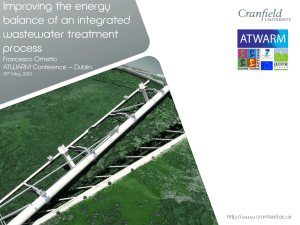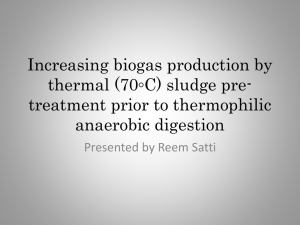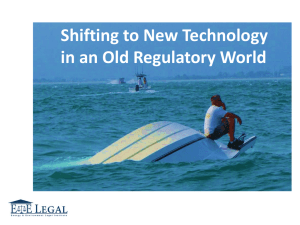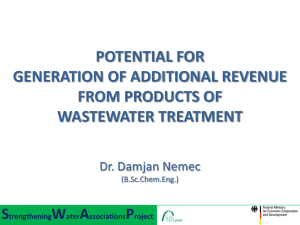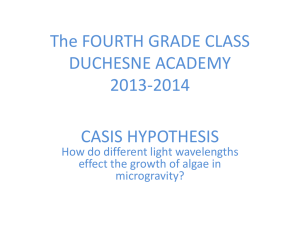Uppdragsrapport
advertisement
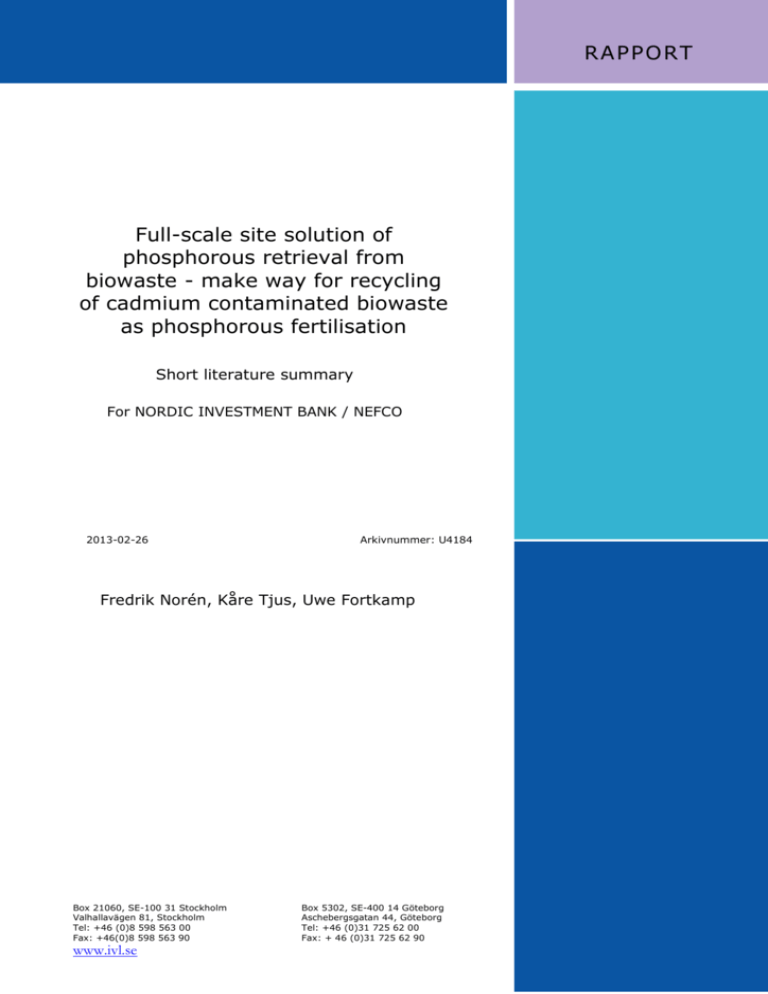
RAPPORT Full-scale site solution of phosphorous retrieval from biowaste - make way for recycling of cadmium contaminated biowaste as phosphorous fertilisation Short literature summary For NORDIC INVESTMENT BANK / NEFCO 2013-02-26 Arkivnummer: U4184 Fredrik Norén, Kåre Tjus, Uwe Fortkamp Box 21060, SE-100 31 Stockholm Valhallavägen 81, Stockholm Tel: +46 (0)8 598 563 00 Fax: +46(0)8 598 563 90 www.ivl.se Box 5302, SE-400 14 Göteborg Aschebergsgatan 44, Göteborg Tel: +46 (0)31 725 62 00 Fax: + 46 (0)31 725 62 90 Innehållsförteckning 1 2 Intro .............................................................................................................................................2 Removal of excess macroalgae from shores ..........................................................................2 2.1 Beach cleaning – ecosystem services ..............................................................................2 2.2 Available biomasses ..........................................................................................................3 2.2.1 Shore algae and biogas potential .............................................................................3 2.2.2 Other substrates that can be used in the process .................................................3 2.3 Biogas potential and production .....................................................................................4 2.3.1 Biogas potential from shore algae ..........................................................................4 2.4 Removal of phosphorus from wastewater.....................................................................5 2.4.1 Possible methods for phosphorus removal ..........................................................6 2.4.2 Large scale technologies in use ...............................................................................7 2.4.3 Description of techniques........................................................................................8 2.4.4 Phosphorus recovery ................................................................................................9 2.5 Separation of heavy metals ..............................................................................................9 2.5.1 Specific use in the macroalgae case ..................................................................... 10 2.5.2 Alternative method with adsorption ................................................................... 11 3 References ................................................................................................................................ 15 1 1 Intro This report gives a short literature background to the PhosCad project. 2 Removal of excess macroalgae from shores 2.1 Beach cleaning – ecosystem services Ecological and physical parameters from beach cleaning has been measured by (Malm et al. 2004). Their findings are summarized in Table 1. They also find a qualitative improvement of the beaches: “The organic content of the sand was reduced by beach cleaning at northern Öland, giving a brighter appearance to the shore and increased stability for visitors walking along the beaches.” Table 1. Summary of effect on cleaned and uncleaned beaches. Data compiled from Malm et al 2004. Oxygen and pH Total nitrogen Ammonia Organic content in sediment Water visibility (secchi depth) Bacterial abundance Protist abundance Species abundance Cleaned beaches Uncleaned beaches No difference No difference Lower conc. of ammonia in water Lower carbon content in outside sediment Improved outside water visibility a Lower bacterial abundance (3 times) in water Higher abundance of bacterivore ciliates No difference, except for mysid shrimps in higher abundances outside uncleaned beaches. a Significant difference for intensively cleaned and uncleaned. No effect for moderate cleaned beaches. Long-time harvest of shore macroalgae was studied in Australia (Lavery, Bootle, and Vanderklift 1999). The results showed that harvested beaches suffered in the short timescale (days-weeks) from the harvest but the beach thereafter was more similar to a “natural” shore with small amounts of macroalgae. They conclude that beach-cleaning is a possible management tool for eutrophicated areas. Other ecosystem services/costs are discussed in (Weslawski et al. 2000; Troell et al. 2004; Morand and Briand 1996). 2 Best time to harvest beach cast algae is before and after the summer period (May and September) according to (Karlsson 2009) and references therein. Management of beach-cleaning is discussed by Bladh (2011), the author states that it is important to avoid extra damage by the harvesting machines such as diesel/oil slips and plan harvest time with animal protection in mind. 2.2 Available biomasses 2.2.1 Shore algae and biogas potential The biomass of algae on vicinity of Simrishamn is presented in Table 2. The potential biogas production is also included and ranges from 130 – 250 Nm3/ton VS (volatile substance – carbon) with a mean of 200 Nm3/ton VS (seven studies and references in Bergström 2012). A case where Karlsson (2009) extrapolates the beach algae to a larger area is also included but has a small significance for this project. Table 2. Literature data on available algae biomass in Simrishamn. References a. Bergström (2012) b. Karlsson (2009) c. Gradin and Tjernström (2012). All calculations are based on 200 Nm3 CH4/ton VS (see Table 3) Yearly biomass production Beach algae yield Data from Simrishamn 2001-2004 Potential harvest from 30 km Potential harvest from 30 km [maximum harvest] Potential harvest from water Potential harvest from Simrishamn area Harvest from Malmö Simrishamn Wet weight (ton) Dry weight (ton) Carbon (ton, VS - volatile substance) Potential CH4 prod (Nm3) Ref. 620 93 27,9 5.580 a 3.500 525 157,5 31.500 a 10.500 1575 472,5 94.500 a 1.200 180 54 10.800 a 70.000 10.500 3.150 630.000 c 287.120 43.068 12.920,4 2.584.080 b The biogas potential from beach algae has been studied by several authors and we refer to (Nkemka and Murto 2010; Nkemka 2012; Davidsson and Ulfsdotter Turesson 2008) that has studied anaerobic digestion on local beach algae. 2.2.2 Other substrates that can be used in the process There could be a benefit for the treatment of algae if the treatment plant (let’s assume an anaerobic digester) is in use 100 % of the time. It is also positive to dilute salts from the marine substrate with low saline substrates and to feed the bacterial process the whole year. This can be achieved by adding municipal organic waste, garden or park waste and reed or other wet land biomass. Trelleborg waste deposit site accepted 1593 tons of garden and park waste and 6452 tons of biodegradable waste (year 2002) and Simrishamn accepted 82 tons of garden and park waste and 3724 tons of biodegradable waste (Avfall Sverige 2003). Reed or wetland biomass has been studied for biogas production by the Wetland-AlgaeBiogas project (Wetlands Algae Biogas - A Southern Baltic Sea Eutrophication Counteract Project. 3 Final Report. 2012) but the potential harvest from such substrate was not stated in the report. The WAB report (ibid.) reported the biogas potential in the Skåne and Trelleborg area for several municipal and farming biogas substrates and where crop residues dominated with 933 GWh from straw and 874 GWh from other crop residues In a recent paper good results were obtained with wheat straw that was pretreated and codigested with lysate (“hydrolysate”) from beach algae and the biogas production ranged from 220-300 Nm3/ton VS (Nkemka and Murto 2013). Since straw has been considered a low efficient biogas substrate this result is interesting and the substrate are easy available. In the Wetland-Algae-Biogas project (Ksawery, Ziolkowski, and Tonderski 2012) it is reported that ~4500 tonnes of wetland plants can be harvested from sewage pumping stations (in the Polish region Sopot). It is not studied if this is a possible substrate in the Trelleborg area, but could be investigated. 2.3 Biogas potential and production 2.3.1 Biogas potential from shore algae Several studies have been conducted to evaluate biogas production potential from algae (Kelly and Dworjanyn 2008) and from beach-cast algae specifically (Table 3). It is clearly shown that different algae and algal mixtures have different biogas potential and that harvest period, pre-treatment and co-digestion with other substrates affects the biogas potential. Fresh and wet algae has higher biogas potential than old and dried algae as example. 4 Table 3. Summary of biogaspotential from beach cast algae and similar substrates. Litterature: (Melin 2001; Wetlands Algae Biogas - A Southern Baltic Sea Eutrophication Counteract Project. Final Report. 2012; Nkemka and Murto 2011; Nkemka and Murto 2010; Morand and Briand 1999; Bergström 2012; Davidsson and Ulfsdotter Turesson 2008) Nm3 CH4 /ton period VS (days) Note Green algae 32 Cladophora Cladophora (boiled in NaOH and 125 mixed) Reference 50:50 Municipal organic waste : algae 200 50:50 Municipal organic waste : algae 290 100 % Municipal organic waste 450 100 % Beach cast algae 170 Ulva cited in Melin 2001 100 % Beach cast algae 100 Ulva cited in Melin 2001 Ulva, Cladophora Hansson 1983 100 % Beach cast algae Melin 2001 Melin 2001 Melin 2001 90-330 100 % Blue mussels (Mytilus edulis) 330 100 % Reed (Phragmites) 212 100 % "raw seaweed" 120 Nkemka et Murto 2010 170 100 % leachate from "raw seaweed" 200-240 Sea Lettuce 80-110 40 UASB rector (dry) 107 Nkemka et Murto 2011 Nkemka et Murto 2011 Mixed samples from beach 130-220 Mixed sample 160-250 -IIBriand et Morand 1997 (Ulva sp 1) Nicolini et Viglia 1985 (in Bergström 2012) Mustafic et al 2009 (in Bergström 2012) Linné et al 2003 (in Bergström 2012) Mixed sample 190-220 Davidsson et al 2008 Sea Lettuce 2.4 Removal of phosphorus from wastewater In recycling of phosphorus (P) from a treatment plant, it is important to characterize the possible removal paths; from the fluid or from the solid sludge. Most methods are designed for one of those fractions and can be categorized into chemical or biological removal of phosphorus, see fig Figure 1. The technologies for recycling of P based on biological methods are commonly called BioP methods, and they utilize certain GAO bacteria that can incorporate P and thereafter release P under anaerobic conditions. This method is suitable for both fluid and solid waste. The second common method is chemical precipitation with aluminium-, calcium- or ferric-oxides and the formation of phosphates. This reaction is done in the primary settlement stage or in a separate stage, i.e. before the sludge formation. If the P removal is done from incinerated sludge ash, it is important to distinguish sludge based on precipitation chemical or if Bio-P was used (Stark 2005). In Sweden the mostly used precipitation chemical is ferric chloride. The proportion of treatment plants that are using Bio-P is ~5 % in Sweden (but e.g. 37 % in Germany). 5 Figure 1. Illustration of different places of installation of phosphorus recovery units (From (Cornel and Schaum 2009) The German project ProPhos (Petzet et al. 2011) studied different methods to remediate phosphorus from sewage water, sludge and ashes, and several large scale studies were conducted. Tyrens perfomed a study for different technologies for the Swedish Environmental Protection Agency (Naturvårdsverket, 2013). 2.4.1 Possible methods for phosphorus removal Based on experience from Bio-P treatment plants some results can be found; a) Small variations in P-concentration is found over the year but larger variations is found during one day. b) The stabilized sludge is a better fraction to remove P from than in the raw waste water – even if the higher TS make separation more difficult. c) The phosphorus removal is dependent on the age of the sludge and d) P-removal before the anaerobic phase is preferable. Based on results from struvite precipitation (MAP, MgNH4PO4) it is concluded that 30 mg P/l is a lower technical limit for MAP precipitation. The economical feasible limit is >200 mg P/l. High levels of DS (dry substance) increases the time needed for precipitation. 6 2.4.2 Large scale technologies in use Swedish methods are presented in Tideström (2009). Other methods have been presented in Pinnekamp et al (2011) and by the Tyrens study (2013).The cost for commercial methods in use is presented in Table 4. Table 4. Summary of costs phosphorus removal technologies Method Euro per kg P Pasch 4,40 Crystalactor 5,9-6,8 Phosnix 7,7-9 P-Roc 3,0-12 Direkt upparbetning av 1, fosfor i löst form avloppsslamaska med behöver fällas tungmetallavskiljning Fix-Phos 2,0 -7 Phoxnan 11-25,0 SesalPhos 7,5-9 Ostara 10 Berlin /Airprex 3 Seaborne 46 Ash Dec 2,20 Reference Pinnekamp et al (2011) Nieminen (2010) Pinnekamp et al (2011) Pinnekamp et al (2011) Pinnekamp et al (2011) Pinnekamp et al (2011) Pinnekamp et al (2011) Pinnekamp et al (2011) Nieminen (2010) Nieminen /Tyréns Nieminen (2010) Pinnekamp et al (2011) Phosphorus remediation using struvite has been reported by (Fransson et al. 2010). They found >90 % phosphorus removal in some cases and very low removal in other using this method on anaerobic digested sludge. The cost for chemicals in this method is ~1,5 – 2€. 7 2.4.3 Description of techniques Table 5. Summary of technologies of heavy metal removal, based on (Pinnekamp et al 2011) Complexity Efficacy Profitable Quality of product No new Experience environmental full scale problem use Method to separat e Method to Process- phosph separate heavy Euro per kg Placement flow orous metals phosphorus Removal from liquid phase Bioptech d A Ads. sel.phos.liq Phostrip + o o + + o d B Crys. sel.phos.liq Prisa + o o + + o d B,C Crys. sel.phos.liq 7,7 to 8,9 Crystalactor + o + + + + d B,C Crys. sel.phos.liq 5,9-6,8 Pearl Ostara + o + + + + d B,C Crys. sel.phos.liq Phosnix o o o + + + d B,C Crys. sel.phos.liq P-RoC o o o o o o d B,C Crys. sel.phos.liq Recyphos o o o o o - d A Ads. sel.phos.liq Phoseidi o o o o o - d B,C Crys. sel.phos.liq Ekobalans o o o + + (o) d B Crys. sel.phos.liq 10 3 to 12 Removal from sludge without leaching Berlin* o - o + + o d 4 Crys. sel.phos.liq FIX-Phos o - o o + - d 4 Crys. sel.phos.sol Airprex o - (+) + + o d 4 Crys. sel.phos.liq + d 5 Crys. acid+complex + d 4 Crys. acid+membr. 3 2 to 7 Removal from sludge with leaching Stuttgart processen + Phoxnan 11 to 25 Seaborne - + - + - o d 5 Crys. acid+Me-sulfide Loprox/PHOXNAN - + - + - - s 4 Crys. acid+membr. 46 Aqua Reci - + - + - o s 4 Crys. sel.acid,acid+Me-prec. Cambi - + - + - o s 5 Crys. no info Krepro - + - + - o s 5 Crys. no info + o o - - c 6 Crys. acid+P-prec. c 6 Crys. Removal from ash - wet chemistry Sephos - SesalPhos acid+P-prec. 7,5 to 9 PASCH - + o + o o c 6 Crys. HCl +solv. 4,40 BioCon - + o m.d. m.d. m.d. m.d. 6 Crys. H2SO4+ionX BioLeaching o + o + o - c 6 Crys. bact.diss. P ,sel.phos.liq Leaching with H 2SO4+Me sep. o + + (+) o (+) c 6 Dissolvedacid+Me-prec. 1 Removal from ash - thermic metallurgic Mephrec o + o o o o s 6 in ash. melt + gas Ash Dec o + (+) (+) o o c 6 in ash. sel.MeCl Removal from partial flows (urine and faeces) Precipitation + + o + o o d,s Crys. Evaporation o + o + o o d,s Crys. Compost + o o + + + d,s In compost Process water A) Outgoing water B) Reject water from different partial flows, e.g. Bio-P C) Water from sludge dewatering Placement d) Decentral s) Semicentral c) Central Methods for metal separation sel.phos.liq Selective phosphorus leaching in liquid phase acid+complex Acid leaching and compexation of metals sel.acid Selective acid leaching of phosphate acid+Me-prec. Acid leaching and selective precipitation of heavy metals acid+P-prec. Acid leaching and selective precipitation of phosphorus sel.MeCl Selection before incineration sel.phos.sol Selective phosphorus precipitation in sludge acid+membr. Acid leaching and membrane selection of phosphate acid+Me-sulfide Acid leaching and sulphide precipitation melt + gas Metals melts at 2000 C and is separated in fume HCl +solv. Acid leaching HCL and extraction of M-Cl complex H2SO4+ionX Acid leaching H2SO4 and ionic exchange of heavy metals bact.diss. P Leaching of phosphorus from ash with bacteria 8 2,2 2.4.4 Phosphorus recovery Table 2 lists techniques for phosphorous recovery. For water solutions, crystallization of phosphorus crystal, CaPO4 or MgNH4 PO4, struvite, are the most common methods to recover phosphorus, but adsorption on natural or synthetic material are also possible methods. For crystallization mostly Mg + NaOH or Ca(OH)2 are added, but in some processes the calcium present in the solution can be used for precipitation and only addition of crystal seeds are needed. The amount of phosphorus that can be recovered is in the range 30-80 %. It is advantageous for the recovery efficiency if Bio-P is used. It is also possible to either treat the sludge or the ash after incineration of sludge to get out a recoverable phosphorus fraction. The AirPres Berlin method strips the CO2 in the sludge after the anaerobic which rises the pH, thus no extra base but only magnesium is needed to form struvite. The formed struvite crystals can be separated gravimetrically from the sludge and after washing used as nutrient. In the Fix –Phos-process, calcium silicate hydrate is added as seed into the anaerobic reactor. After 10 days CaPO4 crystals are formed that can be separated from the sludge by sieves. In other methods the sludge is treated with acids in order to dissolve the phosphate before crystallization. These methods are more effective but also more costly due to increased chemical costs. Another alternative is to use bacteria for leaching of phosphorus from ash in the bioleaching process For ashes mostly acid is used to dissolve the phosphorous, but for Memphrec and Ash Dec, the phosphate is recovered from sludge before burning. 2.5 Separation of heavy metals When separating phosphate crystals from outgoing water, reject water, and water from sludge dewatering, the heavy metals will be remain in the sludge. Sludge is treatment with acid before crystallisation for better phosphorus recovery also causes dissolution of heavy metals. Different methods are used to separate these metals from the phosphorous. In the Stuttgart process metal complexation with citric acid is used. Other methods are membranes (Phoxnan), sulphide removal (Seaborne), solvent extraction (Pasch), ionexchange (Bio-con). It was shown that it is possible to dissolve phosphorous from ashes without dissolving heavy metals. This method still might need a separation of heavy metals from the acid after dissolution might be used (Aqua Reci method with super critical treatment of sludge). It is also possible to separate heavy metals in the burning process, in Ash Dec metals are forming metal chlorides before incineration by addition of chloride salts, these metals chlorides have lower vaporisation temperatures than the metals and can after vaporisation be separated from the gases. In the Mephrec method, the burning is proceeded at higher temperatures, 2000 °C, so that all heavy metals are evaporated without addition of chlorides. In both processes phosphorus is staying in the ash. 9 2.5.1 Specific use in the macroalgae case With the limited data available for treatment costs, Ash Dec is a promising alternative from a cost perspective; however it is intended to be used for large units, treating 25000 tons of ash per year. If all algae between Simrishamn and Malmö are used for biogas production a sludge amount of 43.000 tons of dry biomass can be harvested. In a shorter perspective this method could be of interest if it is also used for other biogas sludge applications. In that case the biogas sludge from algae could be used in the same unit. Also leaching from ash with sulphuric acid followed with metal precipitation is cost effective, but central method. However, the cost do not include phosphor removal, the phosphorous acid is meant to be used as chemical for fertilizer production. Furthermore, it is important that the iron content is low in the phosphorous acid, which might not be the case if origin if sludge if iron chloride precipitation is used for phosphorus-removal. Another interesting method if not only the phosphorus fraction but also the nitrogen fraction are of interest is the use of N-recovery methods as demonstrated by the Swedish firm Ekobalans. One important question in phosphorus recovery methods including separation of cadmium from phosphorous is the use of the residue. Methods that selectively removes phosphorous from the sludge, will give a remaining sludge with less value. Also the phosphorus recovery rate is in many cases not high. Methods that selectively remove heavy metals from sludge such as ion exchange or selective sulphide precipitation can be interesting. An important aspect is if the acid content in the acidification step for biogas is sufficient to dissolve cadmium. The Stuttgart process for example uses pH below 2. Pre-hydrolysis will only result in pH 4 but it could work by addition of HCl or organic acids to achieve pH 3. Also the cost for the addition of NaOH and the problem with the Cadmium chitosan residues are important to consider. 10 2.5.2 Alternative method with adsorption 2.5.2.1 Methods using organic waste There is a growing literature on the use of organic waste as adsorbents and ion-exchange material and their role in removal of heavy metals in contaminated matrixes. The field is partially included in section 2.5.1 based on available techniques. This section deals with organic adsorbents from a more development point and may not be commercial available yet. Some adsorbent have very high capacity to adsorb cadmium, in Table 7 data are compiled from a large review of organic adsorbents with cellulosic origin, and e.g. Eucalyptus, brown algae, saw dust and some carbons have capacities to remove up to 200 mg Cd/g adsorbent. A more ~conservative removal capacity is estimated to 20 mg Cd/g adsorbent. In the case of removing all cadmium from a treatment plant in Simrishamn, the amount of organic adsorbent that would be needed to remove 2 – 16 kg Cd could be estimated to be less than 10 tonnes (assuming a adsorption capacity of 20 mg/g DW and a process efficaty of 10 %), see Table 6. Research has been conducted by Yulia Kalmykova at Chalmers that reported a high Cd removal with shrimp shells rich in the substance chitosan (Kalmykova 2009; Kalmykova, Strömwall, and Steenari 2008). The adsorption potential of different organic materials (all were waste material) and chitosan was the most promising agent. Kalmykova et al. (2009) also investigated the effect of salinity, low temperature and drying on the adsorbent, the results shows low inference on the adsorption from those factors. In the case of salinityaddition the adsorption decreased during a period but adjusted to the new environment after a short time. (Nkemka and Murto 2010) reported a cadmium removal of 75% by using a cryogenic gel. This is the same percentage removal reported by (Davidsson and Ulfsdotter Turesson 2008). The total removal is calculated as both the extraction and adsorption of cadmium. Table 6. Amount of adsorbent needed to remove cadmium in a treatment plant in Simrishamn Adsorbent capacity (g Cd/kg DW) = 0,1 Amount Cd to remove (kg) Data from 2001-2004 Harvest from 30 km Harvest from 30 km [maximum harvest] Harvested from water Potential harvest from Simrishamn area Adsorbent (kg) @ efficacy = 10% 0,14 75 0,79 400 2,36 0,27 15,75 11 1250 125 7500 Table 7. Summary of different adsorbents of interest. Compiled from (Hubbe, Hasan, and Ducoste 2011). Adsorbent Papaya (hardwood) Spruce sawdust, phosphorylated Juniper fiber Juniper wood Pinus sylvestris, hardwood Pine bark Pine bark Pine bark Tree barks Eucalyptus Pine bark Eucalyptus (bark) Coniferous bark Juniper bark Bark Conifer needles Petiolar sheath Tobacco dust Teak leaves Pine cone Brazil nut shell Hazel nuts Hazel nut shell Coconut copra Coconut copra Green coconut Rice husk Rice husk Rice husk Rice husk Rice husk Lathyrus husk Black gram husk Black gram husk Mung bean husk Rice husk Rice husk Sargassum algae Sargassum algae Laminaria japonica Seaweed waste Sargassum fluit. Chlorella vulgaris Fucus spiralis Oedogonium Oedogonium Fucus dead Three brown algae (asco, fucus, sargassum) Marine algae Fucus vesiculosus Aeromonas cavi. (bacteria) Pantoea (bacteria) Streptomyces (bacteria) Staphylococcus Saccharomyces (yeast) Penicillum (fungi) Various fungal Lignin isolated Pulping ligning Capacity (mg/g DW) 18-142 56 9-30 3 9 Note Phosphorylated NaOH Smaller particles higher uptake, higher pH gives better results 9-38 10-13 12-20 47 15 50 252 10-14 10 28 8-18 11 30 30 2-11 19 3,5 5 36-47 1,7 236 90 24-27 8 8-20 12 35 39 40 36 1,5 9-20 71 103 124 60-140 34-302 87 64 80-89 31-35 90 Higher pH favored Pellets, citric acid CH2O CH2O best pH 5,5 PO43H2SO4 Ca, Mg Epichlor Na2CO3 95% uptake regen with HCL regen with HCL Epichlor diff treatments dead algae dried algae dried +NaOH dried + acid 73-215 124 337 124-155 54 63 164 3-70 210 31-63 48 8 CH2O, best pH 3,5 CaCl2, heat CH2O PAA 12 Reference Iqbal et al 2007 Holan et Volesky 1995 Min et al 2004 Shin et al 2004 Taty - Costodes et al 2003 Al-Asheh et Duvnjak 1998 Argun et Dursun 2008 Argun et al 2009 Gaballah & Kilbertus 1998 Ghodbane et Hamdaoui 2007 Oh et Tshabalala 2007 Saliba et al 2002 Seki et al 1997 Shin et al 2007 Randall et al 1974 Aoyama et al 1991 Iqbal et al 2002 Qi et Aldrich 2008 Rao et al 2010 Argun et al 2008 Basso et al 2002 Bulut et Tez 2007 Cimino et al 2000 Ho et Ofomaja 2006 Ofomaja et Ho 2008 Pino et al 2006 Ajmal et al 2003 El-Shafey 2007 Krishnani et al 2008 Kumar et Bandyopadhyay 2006 Kumar et Bandyopadhyay 2007 Panda et al 2006 Saeed et Iqbal 2003 Saeed et al 2005 Saeed et al 2009 Tarley et Arruda 2004 Upendra et Manas 2006 Chen et Yang 2005 Fourest et Volesky 1996 Ghimire et al 2008 Romero-Gonzales et al 2001 Scheiwer et Volesky 1995 Aksu et Donmez 2006 Cordero et al 2004 Gupta et Rastogi 2008 Gupta et Rastogi 2009 Herrero et al 2006 Holan et al 1993 Matheickal et al 1999 Rincon et al 2005 Loukidou et al 2004 Ozdemir et al 2004 Selatnia et al 2004 Ziagova et al 2007 Various Deng et Ting 2005 Yin et al 1999 Basso et al 2004 Calik et Demirbas 2005 Adsorbent Capacity (mg/g DW) Kraft lignin Kraft lignin Tannic acid Compost Peat moss Anaerobic sludge Sugar bagasse Chitosan cellulose Cellulose Cellulose 52 137 1,5 18 32 60 88-149 36 180 86 Undaria pinnifatida 30 strains Cellulose Cellulose powder Saw dust Wood meal Bakers yeast Activated carbon (bean husk) Pecan shell Date pits Carbon Flax shive (carbon) Sugar beet pulp Bagasse fly ash high 269 402 180 76-168 76-168 95 180 112 110-160 5-50 664 68-73 1-10 Note DMF, ion exchange with Ca NaOH+EDTA Succin. Mercerized Xanthation increased adsorption 3x. H3PO4 amidoxylated amidoxylated PAA, grafted Acrylic acid HNO3 Air, H3PO4 HNO3 H3PO4 H3PO4 Reference Crist et al 2004 Mohan et al 2006 Ucer et al 2006 Ulmanu et al 2003 Sari et al 2008 Hawari et Mulligan 2006 Karnitz et al 2009 Zhou et al 2004 Belhalfaoui et al 2009 Gurgel et al 2008 Kim et al 1999 Klimmek et al 2001 Saliba et al 2001 Saliba et al 2002 Geay et al 2000 Marchetti et al 2000 Yu et al 2007 Chavez-Guerrero et al 2008 Dastgheib et Rockstraw 2002 El-Hendawy 2009 Various Marshall et al 2007 Ozer et Tumen 2003 Various Demirbas (2008) also reviews the literature and chemical processes of heavy metal adsorption by organic substances. 13 2.5.2.2 Innovative steps The processes of anaerobic digestion and metal recovery could be combined in the same treatment/anaerobic digestion plant using organic adsorbents in direct connection to the digester, see Figure 2. UASB anaerobic digester with organic cadmium adsorbent ”Vassle” as acid stimulator Beach algae + Municipal waste In separate batches Hydrolysis Acidification CH4 CH4 Perkulation Grinder/ extruder methanogenis Soil P-removal Chitosan NaOH Cadmium removal in chitosan Figure 2. Conceptual anaerobic process with cadmium and phosphor removal. Cadmium is an active process (adsorption/ion-exchange) and phosphorus removal is a passive process with the outgoing soil production. The basic principle is that an UASB reactor can deal with solid waste such as algae and municipal plant waste. The system is well proven. o The content of sand is acceptable. o Pre-treatment and harvest factors improving biogas yield are known for the process The liquid phase of the process is preferable to use as Cd removal using organic adsorbents/ion exchange based on research literature The solid phase may be extruded (crushed) on inlet to enhance Cd elution o The diary waste product “vassle” will be used to lower pH The process can accept batches of substrate (when algae are harvested) and in meantime digest other sources of low-Cd material. o Digested material will be composted from each batch (with CH4 capture) and after Cd analysis mixed to sellable garden soil (once per year) Cd levels will be controlled in final soil Possible business case (“Buy a part of your cleaned beach”) 14 3 References Avfall Sverige. 2003. Avfallsanläggningar Med Deponering - Statistik 2002. RVF rapport 2003:08. RVF Rapport. Avfall Sverige. Bergström, K. 2012. “Impact of Using Macroalgae from the Baltic Sea in Biogas Production: A Review with Special Emphasis on Heavy Metals”. Master degree, LNU. http://lnu.diva-portal.org/smash/record.jsf?pid=diva2:541578. Bladh, Martin, Fredrik Löfstrand, Henrik Pernmyr, Rita B. Jönsson, and Carina Pålsson. 2011. Restriktioner Vid Nyttjande Av Marina Substrat För Biogasproduktion2011:12. Meddelandeserien. Länsstyrelsen i Kalmar län. Cornel, P., and C. Schaum. 2009. “Phosphorus Recovery from Wastewater: Needs, Technologies and Costs.” Water Science & Technology 59 (6) (March): 1069. doi:10.2166/wst.2009.045. Davidsson, Åsa, and Eva Ulfsdotter Turesson. 2008. Tång Och Alger Som En Naturresurs Och Förnyelsebar Energikälla - Sammandrag Av Rapport Steg 2Uppdragsnummer 1269. Trelleborgs kommun. Demirbas, Ayhan. 2008. “Heavy Metal Adsorption onto Agro-based Waste Materials: A Review.” Journal of Hazardous Materials 157 (2): 220–229. Fransson, Liisa, Sofia Löwgren, Gunnar Thelin, and Ekobalans Fenix. 2010. Återvinning Av Näringsämnen Från Rötrest Genom StruvitfällningSGC 218. Svenskt Gastekniskt Centrum. Gradin, Matilda, and Ellinor Tjernström. 2012. “Techniques for Collecting Algae in Sopot and Trelleborg”. Powerpoint presented at the Wetlands-Algae-Biogas. http://wabproject.pl/files/file/pdfwab/Municipality%20of%20Trelleborg.pdf. Hubbe, Martin A, Syed Hadi Hasan, and Joel J Ducoste. 2011. “Cellulosic Substrates for Removal of Pollutants from Aqueous Systems: A Review. 1. Metals.” BioResources 6 (2): 2161–2287. Kalmykova, Yuliya. 2009. Alternative sorption materials for contaminated water treatment. Göteborg: Chalmers Univ. of Technology. Kalmykova, Yuliya, Ann-Margret Strömvall, Sebastien Rauch, and Greg Morrison. 2009. “Peat Filter Performance Under Changing Environmental Conditions.” Journal of Hazardous Materials 166 (1): 389–393. Kalmykova, Yuliya, Ann-Margret Strömwall, and Britt-Marie Steenari. 2008. “Alternative Materials for Adsorption of Heavy Metals and Petroleum Hydrocarbons from Contaminated Leachates.” Environmental Technology 29 (1): 111–122. Karlsson, Sara. 2009. “Sustainable Use of Baltic Sea Natural Resources Based on Ecological Engineering and Biogas Production : System Analysis and Case Study Trelleborg”. KTH, Industrial Ecology. Kelly, MS, and S Dworjanyn. 2008. “The Potential of Marine Biomass for Anaerobic Biogas Production: a Feasibility Study with Recommendations for Further Research.” Scotland: Scottish Association for Marine Science. Ksawery, Kuligowski, Marek Ziolkowski, and Andrzej Tonderski. 2012. “Feasibility Study in Pomerania (part 2)”. Powerpoint presented at the Wetland-Algae-Biogas final meeting, November 28, Trelleborg. 15 Lavery, P., S. Bootle, and M. Vanderklift. 1999. “Ecological Effects of Macroalgal Harvesting on Beaches in the Peel-Harvey Estuary, Western Australia.” Estuarine, Coastal and Shelf Science 49 (2): 295–309. Malm, Torleif, Sonja Råberg, Sabine Fell, and Per Carlsson. 2004. “Effects of Beach Cast Cleaning on Beach Quality, Microbial Food Web, and Littoral Macrofaunal Biodiversity.” Estuarine, Coastal and Shelf Science 60 (2) (June): 339–347. doi:10.1016/j.ecss.2004.01.008. Melin, Ylva. 2001. Alternativ Användning Av Marina Fintrådiga Alger2001:41. Länstyrelsens Rapportserie. Göteborg: Länsstyrelsen Västra Götaland. Morand, P., and X. Briand. 1996. “Excessive Growth of Macroalgae: a Symptom of Environmental Disturbance.” Botanica Marina 39 (1-6): 491–516. Morand, Philippe, and Xavier Briand. 1999. “Anaerobic Digestion of Ulva Sp. 2. Study of Ulva Degradation and Methanisation of Liquefaction Juices.” Journal of Applied Phycology 11 (2): 164–177. Nieminen, Jenni. 2010. “Phosphorus Recovery and Recycling from Municipal Wastewater Sludge”. Masters thesis, Aalto: Aalto University. http://civil.aalto.fi/fi/tutkimus/vesi/opinnaytteet/nieminen2010.pdf. Nkemka, Valentine, and Marika Murto. 2011. Torrötning Av Musslor Och Vass i TvåstegsprocessSlutrapport. Lunds Universitet, Avdelnignen för bioteknik. Nkemka, Valentine Nkongndem. 2012. “Two-Stage Conversion of Land and Marine Biomass for Biogas and Biohydrogen Production”. PhD dissertation, Lund: Lund University. Nkemka, Valentine Nkongndem, and Marika Murto. 2010. “Evaluation of Biogas Production from Seaweed in Batch Tests and in UASB Reactors Combined with the Removal of Heavy Metals.” Journal of Environmental Management 91 (7): 1573–1579. 2013. “Biogas Production from Wheat Straw in Batch and UASB Reactors: The Roles of Pretreatment and Seaweed Hydrolysate as a Co-substrate.” Bioresource Technology 128 (0): 164 – 172. doi:10.1016/j.biortech.2012.10.117. Petzet, S, P. Cornel, M Beier, K.-H. Rosenwinkel, R Pikula, V Sperlich, A Ehbrecht, D Patzig, S Schönauer, and R Schuhmann. 2011. BMBF-Verbundprojekt ProPhos: Phosphor-rückgewinnung Aus Abwasser, Klärschlamm Und Rückständen Thermischer Klärschlammbehandlung. Aachen: GEWÄSSERSCHUTZ – WASSER – ABWASSER. http://www.phosphorrecycling.de/index.php?option=com_content&task=blogcat egory&id=11&Itemid=25&lang=en. Pinnekamp, J., W. Everding, Katrin Gethke, David Montag, Karlheinz Weinfurtner, Christian Sartorius, Jana Von Horn, et al. 2011. Phosphorrecycling – Ökologische Und Wirtschaftliche Bewertung Verschiedener Verfahren Und Entwicklung Eines Strategischen Verwertungskonzepts Für Deutschland (PhoBe). Gewässerschutz, Wasser, Abwasser. Bundesministerium für Bildung und Forschung., J., W. Everding, Katrin Gethke, David Montag, Karlheinz Weinfurtner,. http://www.phosphorrecycling.de/index.php?option=com_rokdownloads&view= file&Itemid=67&id=73&lang=de Stark, Kristina. 2005. “Phosphorus Release and Recovery from Treated Sewage Sludge”. PhD thesis, KTH. http://kth.diva-portal.org/smash/record.jsf?pid=diva2:10421. Tideström, Henrik, Lars Alvin, Ulla Jennische, and Bengt Hultman. 2009. Fosforutvinning Ur Avloppslam. Rapport Uppdragsrapport 1150 744 000. Stockholm: SWECO. http://www.naturvardsverket.se/upload/stod-i- 16 miljoarbetet/vagledning/avloppsslam/Slutrapport%20till%20NV_Putvinning_Teknik%20milo%20halsa%20klimat%202009_Rev%284%29.pdf. Troell, Max, P. Leif, Patrik Rönnbäck, Håkan Wennhage, Tore Söderqvist, and Nils Kautsky. 2004. When Resilience Is Undesirable: Regime Shifts and Ecosystem Service Generation in Swedish Coastal Soft Bottom Habitats. Beijer International Institute of Ecological Economics. http://geminis.dma.ulpgc.es/profesores/personal/jmpc/Master08(PrimeraEdici% F3n)/Resiliencia/Resili12s.pdf. Weslawski, Jan Marcin, Barbara Urban-Malinga, Lech Kotwicki, Krzysztof Opalinski, Maria Szymelfenig, and Marek Dutkowski. 2000. “Sandy Coastlines-are There Conflicts Between Recreation and Natural Values?” Oceanological Studies 29 (2): 5. Wetlands Algae Biogas - A Southern Baltic Sea Eutrophication Counteract Project. Final Report. 2012. Municipal of Trelleborg. 17

